If you are a nature lover, mountaineer, or active traveler, it is highly recommended not to miss a trip to Lar National Park. Lar Plain, located on the border between Tehran and Mazandaran provinces, is one of the most beautiful and pristine natural areas in Iran. This plain is situated in a mountainous region and offers a stunning view of the unique Damavand peak. Additionally, various activities such as mountaineering, boating, cycling, and fishing are possible in this park. By visiting this area in the spring season, especially in the months of May and June, you can also enjoy the beauty of poppy fields. To learn more about Lar National Park and Lar Plain, the climate and weather conditions of the region, and the visiting requirements, please refer to the articles prepared by Eligasht Tourism magazine.
Book Iran Air flights from London to Tehran and Tehran to London with Eligasht UK:
Where is Lar National Park?
Lar Protected Area, also known as Lar National Park, is located on the border of Tehran and Mazandaran provinces in central Alborz, near the southwestern slopes of Mount Damavand. It is situated approximately 70 kilometers east of Tehran. It’s worth mentioning that Lar Plain covers an area of about 753,000 hectares, of which only around 31,000 hectares are recognized as Lar National Park.
This protected area serves as a habitat for various plant and animal species and boasts a breathtaking and unspoiled natural environment facing the Damavand Peak. Furthermore, there are no residential settlements within this area, which is considered one of its main advantages.
History of Lar National Park
According to historical records, the name “Lar” has been mentioned in various periods. Due to its pleasant and unique climate, Lar has been a resting and recreational place for kings throughout different eras in Iran. In the past, the Lar region was considered part of the historical Qasran area, which was under the jurisdiction of Rey City, and it was also known as “Lar Qasran.” However, later in 1975, it gained special fame among the people under the name “Lar National Park.”
It is important to know that in 1982, with the approval of the Supreme Council of Environmental Protection, the level of protection for Lar Plain was reduced, but in 1991, certain parts of it were recognized as Lar National Park.
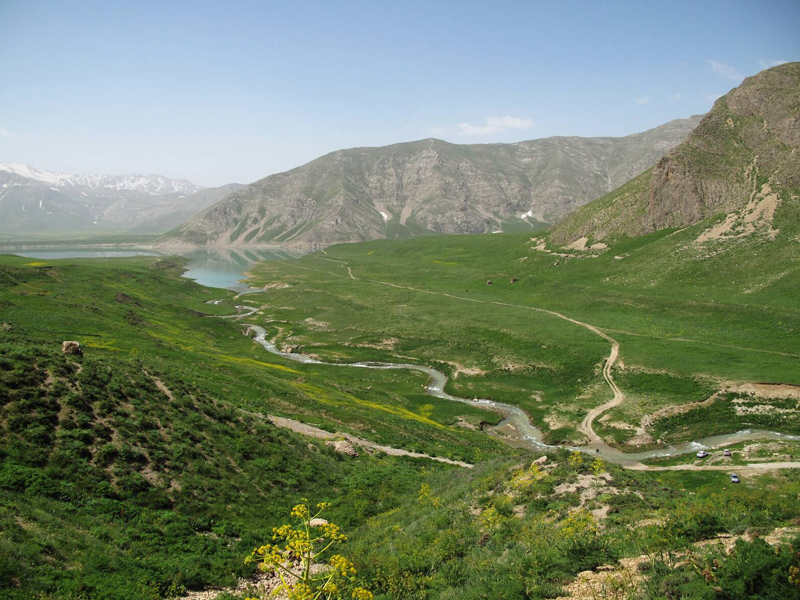
Plant and Animal Species of Lar National Park
Lar National Park, due to its favorable climate, moderate weather, abundant vegetation cover, and numerous rivers, is home to various plant and animal species. The presence of some rare species in this area has led to increased protection measures and the prohibition of hunting and shooting in certain areas. Let’s take a closer look at the plant and animal life in Lar National Park:
Plant Species of Lar National Park
In the Lar National Park area, there are approximately 400 plant species belonging to around 48 families. Out of these species, about 338 are permanently present in the region, while the rest are seasonal. It’s worth mentioning that about 35 species are specific to the Iranian climate.
These plant species include various evergreen plants, medicinal herbs, and colorful flowers such as tulips, poppies, thyme, chicory, lovage, wild garlic, wild onions, wild mushrooms, dandelion, marigold, sweet briar, mountain tea, chamomile, and valerian. Additionally, there are beautiful flowers like wild purple and mauve lilies, anemones, yellow flowers, and poppies.
It’s important to note that due to the vast and flower-rich meadows of Lar National Park and its plant diversity, beekeeping activities take place in this area from early May to late September. The stunning beauty of the vegetation cover in this region has captivated nature enthusiasts and environmentalists.
Species of Lar National Park
Due to Lar National Park’s mountainous and water-rich location with a unique climate, it is home to various animal species, including birds, mammals, and reptiles. The species found in Lar National Park include:
– 100 rare bird species, including bustards, eagles, hawks, vultures, flamingos, pelicans, cranes, and golden eagles.
– Mammal species such as goats, sheep, rabbits, porcupines, Central Alborz mule deer, brown bears, leopards, wolves, foxes, ibex, and wildcats.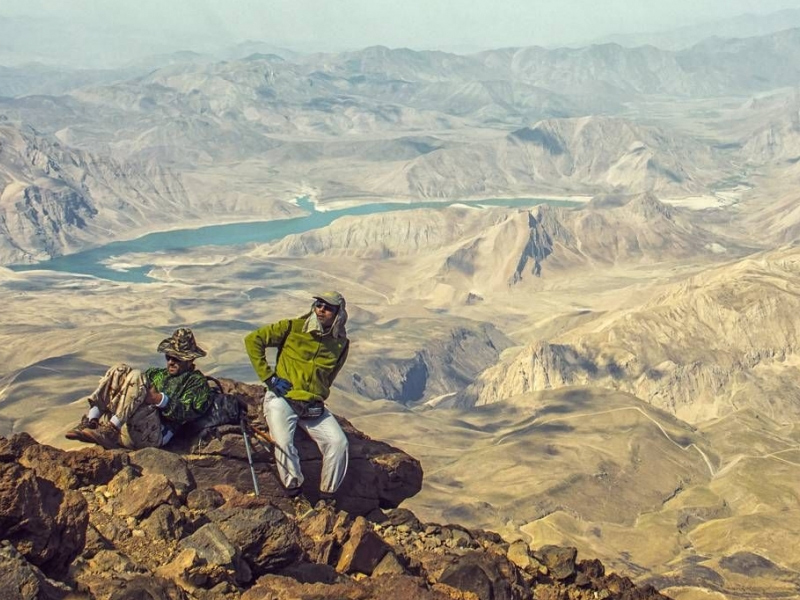
– Beautiful reptiles and amphibians such as snakes, Damavand viper, Alborz viper, snakes, shrews, owls, turtles, and frogs.
– Red-spotted rainbow trout, which is the rarest species of rainbow trout. It’s worth mentioning that the red-spotted rainbow trout has two types, resident and migratory. The migratory type used to migrate from Lake Lar to the Caspian Sea, but due to the construction of the Lar Dam, it now goes to this lake.
Related post
Battle of ice and fire in Tehran Ab-o-Atash Park
Introduction to the ancient symbol of the capital Iran: Tehran National Garden
Exploring the Historical Sites in Tehran: A Journey Through Iran’s Capital
Lar National Park Recreational Activities
Lar National Park, in addition to its pristine nature and breathtaking landscapes, offers various recreational activities for visitors to enjoy the surrounding scenery and the excellent weather. Some of these activities include:
- Hiking and Mountaineering: Due to the park’s mountainous location, it provides opportunities for hiking and mountaineering enthusiasts. Famous Iranian mountains such as Mount Damavand, Mount Divasiab, Mount Yakh-Kamar, Mount Gol-e zard, Mount Pahnak, Mount Zereshki, Mount Kamardasht, Mount Namak Kusar, Mount Siahchal, Mount Aro Bararo, Mount Asb Kalak, and Mount Kafer Rah are present in this area, offering exciting recreational facilities for mountaineers.
- Fishing: Many tourists are interested in activities such as fishing. The presence of various fish species in the flowing waters of rivers and the Lar Dam allows visitors, with a special fishing permit obtained from the environmental units of Ghushkhaneh, Palur, and Delichay, to engage in fishing from early May to the end of September in the Lar Dam.
- Cycling: Throughout the year, numerous cycling tours take place in Lar National Park, allowing cyclists to explore the pristine nature and pleasant climate of the area while riding on hills and mountain slopes.
- Off-Roading: One of the most thrilling recreational activities in Lar National Park is off-roading, taking advantage of the flat and virgin land of the Lar Plain. However, it’s important to note that off-roading should be done responsibly, considering safety and environmental protection measures to avoid causing irreversible damage to the park’s nature.
- Picnicking and Photography: Lar National Park is one of the best and most suitable natural areas in Iran for relaxation, picnics, and spending time with family. While bonfires are prohibited in the area, you can enjoy the pleasant weather and capture beautiful photos of the Damavand Peak and Poppy Field landscape.
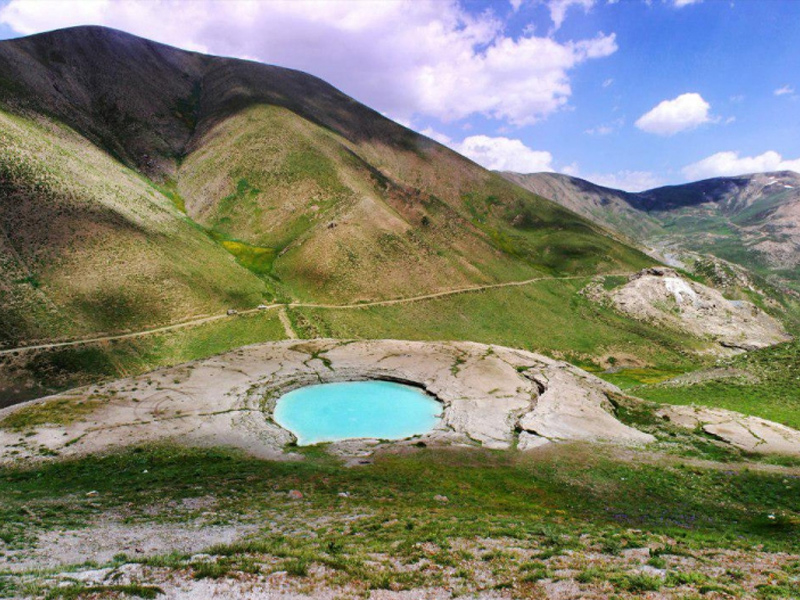
Attractions around Lar National Park
In addition to the natural beauty of Lar Valley, there are other natural and tourist attractions in this area that are highly recommended to visit. Here are some of the attractions around Lar National Park:
1. Lar Dam:
Lar Dam is located 75 kilometers northeast of Tehran and 100 kilometers from Amol city. The construction of this dam began in 1974 and was completed in 1982. The water behind the dam is used to supply the surrounding areas with water. In some months of the year, tourists can obtain a fishing permit and engage in fishing activities at the dam. Additionally, the water from this dam is transferred to the Kalan Power Plant and the Letian Dam for the regional power plants’ use.
2. Poppy Fields:
The Poppy Fields are one of the most beautiful and famous natural attractions in Iran. Visitors can enjoy the sight of these fields and take beautiful photographs during late spring, particularly in the month of May or June, along with their visit to Lar National Park.
3. Divasiab Lake:
Divasiab Lake is a circular lake with a diameter of 20 meters and a depth of 2 meters, located within a limestone hill with a depth of 10 meters. The water in this lake springs from a sour-tasting spring with a temperature ranging from 5 to 10 degrees Celsius. The color of the water varies from light blue to gray due to the water supply and its pollution level.
4. Lar Lake:
There is a lake within Lar National Park that was created as a result of the construction of Lar Dam in 1982. It is considered one of the highest lakes in Iran. With an area of 29 square kilometers, it is fed by rivers such as Ghazal Darreh, Sefidab, and Delichay.
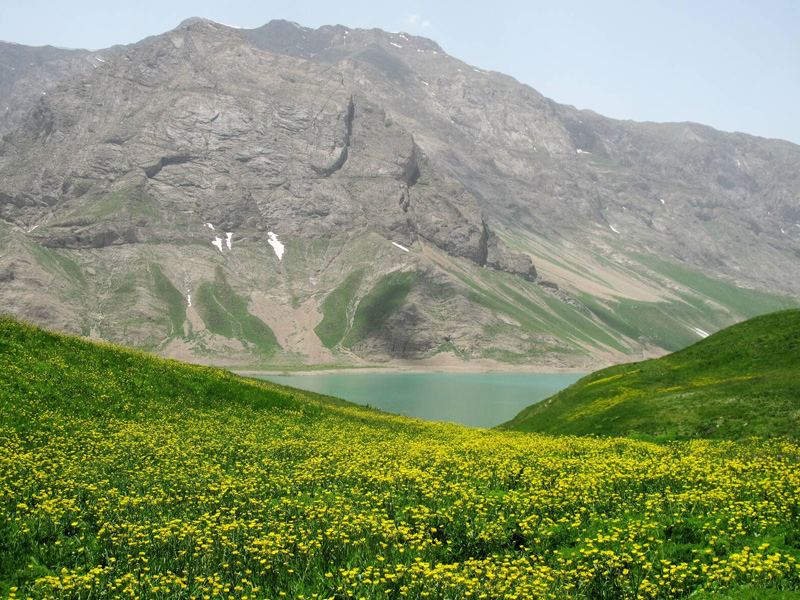
5. Rivers and Lar Waterfall:
Several rivers pass through this area, including Lar River, Divasiab River, Sefidab River, Vararud River, Chehel Bareh, Imam Pahnak Water, and Siahchal Water. These rivers create suitable conditions for various plant and animal species. Lar Waterfall, descending from Damavand, adds a breathtaking view to the region.
In addition to these attractions, there are other historical, natural, and tourist sites around Lar National Park, such as Imamzadeh Hashem, Larijan Hot Springs, and Esk Hot Springs.
Best time to visit Lar National Park
Lar National Park offers pristine and captivating nature throughout the year, with each season showcasing its unique beauty. However, due to the presence of mountains and highlands in this mountainous region, travel and exploration may be hindered and somewhat risky during certain months, especially in the second half of the year, due to rainfall and cold weather.
In general, the months of December and January are the coldest, while July and August are the hottest months of the year. However, the best time to visit Lar National Park is in the month of May or June, coinciding with the blooming of beautiful and unique poppy fields in Lar Valley.
Access Route to Lar National Park
As you know, Lar National Park is located on the border between Tehran and Mazandaran provinces. Therefore, it is possible to access this valley through the highways of these two provinces. By entering the Haraz Road from the end of Babaei Highway and passing through Roodehen and Boomehen, and then Imamzadeh Hashem Pass, the route descends and after traveling about 2-3 kilometers, you will see the majestic peak of Mount Damavand. After a 10-minute drive, you will reach the golden statue of a mountaineer, indicating that you have reached the city of Polur and can enter the side road.
The route to Lar National Park branches off from Abali Road (Tehran towards Amol) inside the city of Polur. This route continues from Polur Square to the entrance post of Delichay Environmental Protection Station, which is the eastern entrance of Lar National Park.
The Garmabdar route can be traveled by private car to Fasham. This route provides access to the western part of Lar National Park and is mostly used by local farmers and tribes. However, it should be noted that you need to obtain a permit from the Garmabdar Hunting Station to pass through this route.
If you are interested in mountaineering, you can take the Lavasan-Afjeh-Dasht-e Havij-Faleh Persoun route, passing through the pass towards Dasht-e Lar, which is approximately near Imamzadeh Panjtan, to reach your destination.
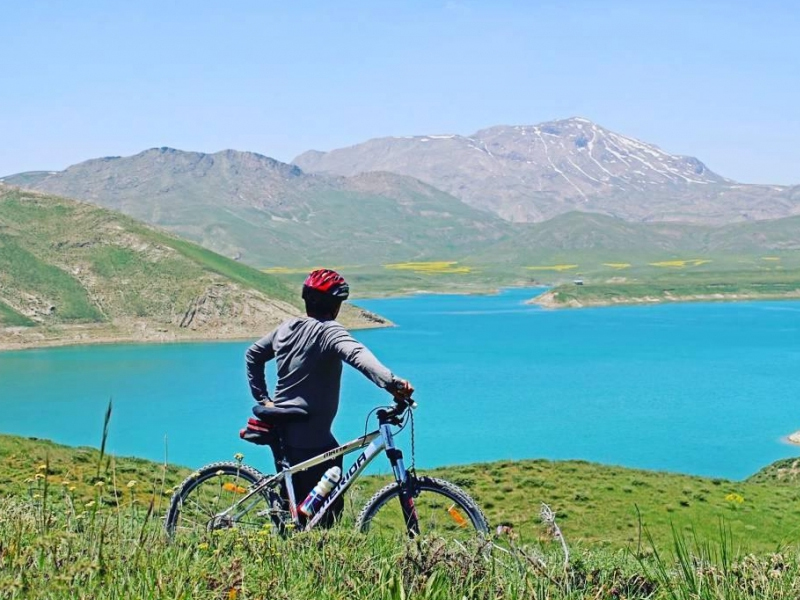
Important Points for Traveling to Lar National Park
Traveling to Lar Park, like other nature exploration and camping experiences, requires the observance of important points. Some of the most important points that you should consider during your trip to Lar Park are:
- Sufficient signal reception for mobile phones may not be available.
- Sun radiation in this area is intense, and there is no natural shade.
- Venomous and dangerous snakes inhabit this area, so using gaiters can reduce the risk to some extent.
- This location contains various animal and plant species, so it is necessary to respect environmental regulations while being there.
- Make sure to bring appropriate seasonal clothing, suitable footwear, sunglasses, sun hat, sunscreen, drinking water, a portable meal, a flask, medication, a mobile phone, a power bank, a backpack, and a trash bag for your trip to the Lar Park.
Final Words
In the above article, we have introduced one of the most beautiful and famous protected areas in Iran, Lar Park, and discussed its natural features and other recreational facilities. This area is of great environmental importance due to its diverse plant and animal species, so visiting it has special conditions. Tourists can engage in recreational activities such as mountaineering, cycling, fishing, boating, picnicking, and off-roading in this area and enjoy the famous and picturesque attractions of the region.
For more information about organizing a tour to Lar Park, purchasing tickets, and booking accommodations in the surrounding cities, you can contact the experts at Eligasht Travel Agency.
FAQ
1- Where is Lar National Park located?
Lar Park is located on the border between Tehran and Mazandaran provinces in the central Alborz region, near the southwestern slopes of Mount Damavand, and approximately 70 kilometers east of Tehran.
2- What is the best time to visit Lar National Park?
The best time to visit Lar Park is during the month of May and June, coinciding with the blooming of beautiful and unique tulips in Dasht-e Lar.
3- What are the necessary items for exploring Lar National Park?
The necessary items include appropriate seasonal clothing, suitable footwear, sunglasses, a sun hat, sunscreen, drinking water, a portable meal, a flask, medication, a mobile phone, a power bank, a backpack, and a trash bag.
4- What are the recreational activities in Lar National Park?
Mountaineering, cycling, fishing, boating, picnicking, and photography are among the recreational activities in Lar Park.
5- Is fishing allowed in Lar Dam?
Yes, you can go fishing in Lar Dam from early Khordad (May/June) until the end of Shahrivar (September) by obtaining a special daily fishing permit.

